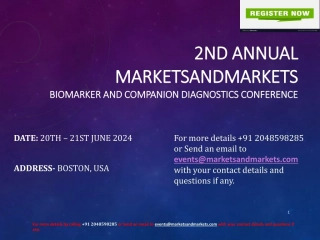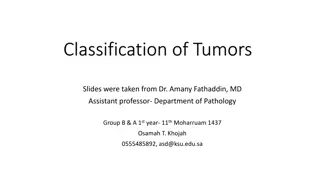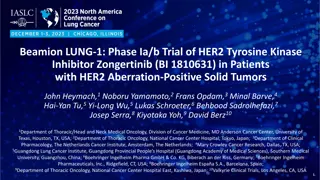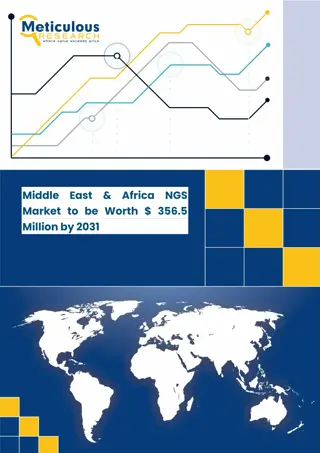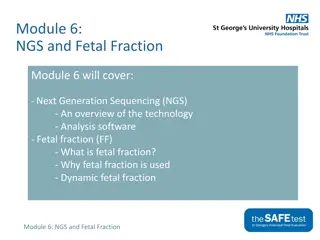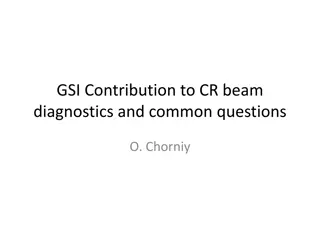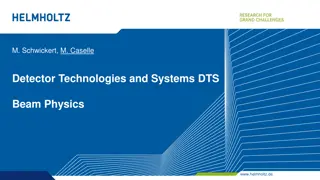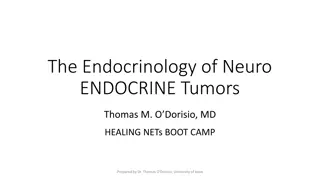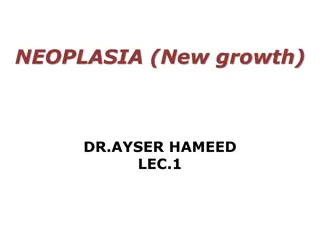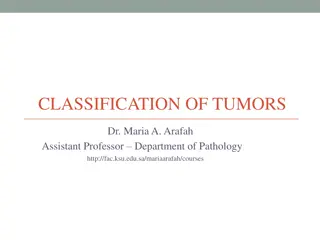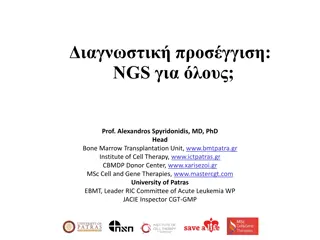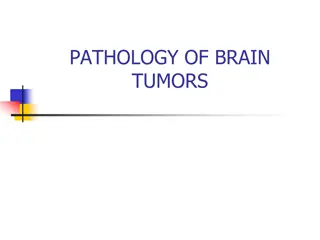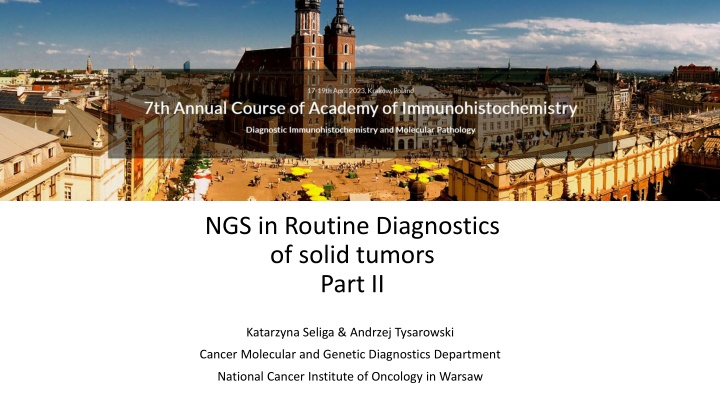
Advanced Molecular Techniques for Solid Tumor Diagnostics
Learn about the latest advancements in molecular diagnostics for solid tumors, including the use of Next Generation Sequencing (NGS) for identifying gene fusions, novel gene partners, and more. Explore the complexity of soft tissue sarcomas and the evolution of genetic techniques in tumor analysis.
Download Presentation

Please find below an Image/Link to download the presentation.
The content on the website is provided AS IS for your information and personal use only. It may not be sold, licensed, or shared on other websites without obtaining consent from the author. If you encounter any issues during the download, it is possible that the publisher has removed the file from their server.
You are allowed to download the files provided on this website for personal or commercial use, subject to the condition that they are used lawfully. All files are the property of their respective owners.
The content on the website is provided AS IS for your information and personal use only. It may not be sold, licensed, or shared on other websites without obtaining consent from the author.
E N D
Presentation Transcript
NGS in Routine Diagnostics of solid tumors Part II Katarzyna Seliga & Andrzej Tysarowski Cancer Molecular and Genetic Diagnostics Department National Cancer Institute of Oncology in Warsaw
Soft tissue sarcomas are rare, heterogeneous and aggressive neoplasms, characterized by high mortality and tremendous morphologic heterogeneity. There are more than 100 different subgroups. They consist 15-21% of all tumors in children, and 1% of all malignant tumors in adults. R. Randall i P. Pisters, Clinical Evaluation and Treatment of Soft Tissue Tumors, w Enzinger and Weiss's Soft Tissue Tumors, Philadelphia, Elsevier, 2020, p. 15.
Durmaz AA, Karaca E, Demkow U, Toruner G, Schoumans J, Cogulu O. Evolution of genetic techniques: past, present, and beyond. Biomed Res Int. 2015;2015:461524. doi: 10.1155/2015/461524.
WHO classification of undifferentiated small round cell sarcomas of bone and soft tissue Round cell sarcoma with EWSR1 non-ETS fusions CIC-rearranged sarcoma CIC-DUX4 CIC-FOXO4 CIC-NUTM2A Ewing sarcoma Sarcoma with BCOR genetic alterations EWSR1-PATZ1 EWSR1-SMARCA5 EWSR1-SP3 EWSR1-NFATC2 FUS-NCATC2 EWSR1-FLI1 EWSR1-ERG FUS-ERG EWSR1-ETV1 EWSR1-ETV4 EWSR1-FEV BCOR-CCNB3 BCOR-MAML3 BCOR-ZC3H7B
memo (2020) 13:159163 https://doi.org/10.1007/s12254-020-00574-4 Kallen ME, Hornick JL. The 2020 WHO Classification: What's New in Soft Tissue Tumor Pathology? Am J Surg Pathol. 2021 Jan;45(1):e1-e23. doi: 10.1097/PAS.0000000000001552.
Material preparation for molecular analysis Pathologist: NGS Library preparation Tumor (%) quantification and tissue macrodissection if neccesery FFPE samples 20% Fluorymeter Quantus Total Nucleid Acid (TNA) isolation NGS Sequencing
Next Next generation generation sequencing sequencing (NGS) (NGS) Identifcation of known and novel gene fusions Identification of novel gene partners Discrimination between active and inactive (out of frame) fusions Identification of breaking points Possibility to estimate the quantity of gene fusion (strong vs weak positive) Ability to analyze multiple genes at one time from the same material. The test material can be RNA, DNA, ctDNA. NGS enables the interrogation of hundreds to thousands of genes at one time in multiple samples, as well as discovery and analysis of different types of genomic features in a single sequencing run, from single nucleotide variants (SNVs), to copy number and structural variants, and even RNA fusions.
FusionPlex Sarcoma Panel targets 26 genes commonly mutated in soft tissue sarcomas FusionPlex CTL Kit targets 36 genes commonly mutated in solid tumor cancers. The diagram shows driver genes and possible partner genes identified with Archer FusionPlex in various soft tissue sarcomas.
NGS panels FusionPlex Sarcoma Gene fusions ALK; CAMTA1; CCNB3; CIC; EPC1; EWSR1; FOXO1; FUS; GLI1; HMGA2; JAZF1; MEAF6; MKL2; NCOA2; NTRK3; PDGFB; PLAG1; ROS1; SS18; STAT6; TAF15; TCF12; TFE3; TFG; USP6; YWHAE FusionPlex Sarcoma v2 CAMTA1; CIC; CSF1; EPC1; ERG; ESR1; EWSR1; FOS; FOSB; FOXO1; FUS; GLI1; HMGA2; JAZF1; MDM2; MEAF6; MET; Gene fusions MGEA5; MKL2; NCOA1; NCOA2; NR4A3; NUTM1; PAX3; PDGFB; PHF1; PLAG1; PRKCA; PRKCB; PRKCD; RAF1; SS18; STAT6; TAF15; TCF12; TFE3; TFG; USP6; VGLL2; YAP1; YWHAE Gene fusions and variants (point mutations, small deletions/insertions, duplications and tandem repeats) Point mutations ALK; BCOR; BRAF; EGFR; FGFR1, FGFR2, FGFR3, NTRK1; NTRK2; NTRK3; RET; ROS1 CTNNB1; MYOD1 FusionPlex Comprehensive Thyroid and Lung variants (point mutations, small deletions/insertions, duplications) Gene fusions and variants Gene fusions AKT1; AXL; CALCA; CCND1; DDR2; KRT70; KRT20; MET; ALK; BRAF; FGFR1; FGFR2; FGFR3; MAP2K1; ROS1; CTNNB1; EGFR; GNAS; HRAS; IDH1; IDH2; KRAS; NRAS; NTRK1; NTRK2; NTRK3; NRG1 PPARG; PTH; RAF1; SLC5A5; PIK3CA; THADA; TTF1
Targeted therapy Histopathology Personalized medicine Diagnostic algorithm for sarcomas Immunohistochemistry (IHC) Fluorescence in situ hybridization (FISH) NGS Therapeutic panel NGS Tumor differential diagnostics panel Pathologist diagnosis
Spindle cell tumour infiltrating fat in a reticular fashion reminiscent of lipofibromatosis. HPC-like vessels https://tumourclassification.iarc.who.int/chaptercontent/33/254 Siozopoulou V, Smits E, De Winne K, Marcq E, Pauwels P. NTRK Fusions in Sarcomas: Diagnostic Challenges and Clinical Aspects. Diagnostics (Basel). 2021 Mar 9;11(3):478. doi: 10.3390/diagnostics11030478. https://www.jpgathology.com/image.asp?case=500&n=11
Soft tissue sarcomas involving NTRK fusion NTRK 1/3 gene Undifferentiated sarcoma (metastatic) ALK Soft tissue sarcoma (NOS) Soft tissue fibrosarcoma (NOS) 5% Inflammatory myofibroblastic tumor (70%) Infantile (congenital) fibrosarcoma (>90%) Schwannoma Epithelioid inflammatory myofibroblastic NTRK1 Spindle cell sarcoma (NOS) with myopericytic & haemangiopericytic sarcoma growth pattern Synovial sarcoma Malignant peripheral nerve sheath tumor (2%) Lipofibromatosis-like neural tumors Ewing sarcoma Soft tissue histiocytic or dendritic cell neoplasm Rhabdomyosarcoma Hemangioma Solitary fibrous tumor ROS1 Infantile (congenital) fibrosarcoma (>90%) Inflammatory myofibroblastic tumor Congenital mesoblastic nephroma (10%) Gastrointestinal stromal tumor (GIST) NTRK3 Inflammatory myofibroblastic tumor (50-60%) Angiosarcoma Malignant peripheral nerve sheath tumor (2%) Soft tissue fibrosarcoma (NOS) 5% Demetri GD at al. Diagnosis and management of tropomyosin receptor kinase (TRK) fusion sarcomas: expert recommendations from the World Sarcoma Network. Ann Oncol. 2020 C. Lovly, A. Gupta, D. Lipson at al. Inflammatory myofibroblastic tumors harbor multiple potentially actionable kinase fusions. Cancer Discov. Ewing s sarcoma Liposarcoma
Results Total number of cases 774. Additionally in 253/393 patients (33%) analyzed with Sarcoma and sarcoma v2 Panel, gene fusions were detected, which allowed to: give the correct diagnosis, confirm the diagnosis or, change the diagnosis (identification of a new gene fusion). Results from 2018 to 2023 National Cancer NIO-PIB Institute of Oncology Jednostki zewn trzne Institutions Other 192; 24,8% 582; 75,2% NGS allowed to identify and classify 22,4 % (32/143) undifferentiated soft tissue tumors.



